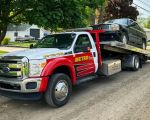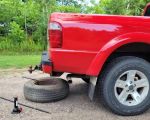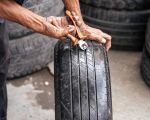- unique-dangers-of-mountain-driving
- immediate-actions-after-a-mountain-pass-accident
- staying-safe-while-waiting-for-help
- real-case-how-a-family-survived-a-mountain-pass-crash
- how-rescue-and-towing-can-help
1. Understanding the Unique Dangers of Mountain Driving
Driving through mountain passes is breathtaking, but it comes with significant risks. Narrow roads, sudden weather changes, steep grades, and limited visibility are just a few of the challenges. These elements make handling a car accident on a mountain pass a very different experience than one on flat roads.
Unlike urban collisions, mountain crashes often occur in remote locations with limited cell service, delayed emergency response, and higher risk of secondary accidents due to blind curves or icy surfaces. Recognizing these dangers ahead of time is crucial for preparation and response.

Les Schwab Tire Center
1694 NW 6th St, Grants Pass, OR 97526, USA
2. Immediate Actions After a Mountain Pass Accident
2.1. Check for Injuries and Secure the Scene
The first and most important step is to ensure your own safety and check for injuries. If possible, move the vehicle off the road to avoid blocking traffic or creating further risk, but only if it’s safe to do so.

Mountain View Tire & Auto Service
16855 Devonshire St, Granada Hills, CA 91344, USA
2.2. Use Hazard Lights and Emergency Signals
Turn on hazard lights and place reflective triangles or flares behind your vehicle to alert oncoming drivers—especially on winding mountain roads where visibility may be compromised. If you have a passenger, have them act as a lookout.
2.3. Call for Help
Even in areas with poor signal, attempt to call 911. If you can’t reach emergency services, note your exact location using landmarks, road signs, or GPS coordinates, and send someone to get help only if conditions are safe.
2.4. Don’t Abandon the Vehicle Without a Plan
In cold or high-altitude areas, exposure becomes a serious threat. Stay with your car unless there's immediate danger (like fire or falling rocks), and conserve energy and warmth.
3. Staying Safe While Waiting for Help
3.1. Manage the Environment
Use blankets, extra clothing, or car heat (intermittently if necessary) to stay warm. If stuck during the day, open windows slightly to avoid carbon monoxide buildup. Keep the vehicle visible to rescuers—hang something bright from the window if possible.
3.2. Document the Incident
Take pictures of the scene, damages, road conditions, and weather. These will be essential for insurance and potential legal follow-up. Avoid discussing fault with others involved; let the authorities handle the report.
3.3. Stay Calm and Collected
Mental clarity is essential. Accidents can trigger panic, but clear thinking can prevent further injuries or errors. If you're with others, designate roles: one person documents, another signals for help, another checks for nearby threats like falling rocks or traffic.
4. Real Case: How a Family Survived a Mountain Pass Crash
In 2021, a family driving through Colorado’s Monarch Pass lost control during a sudden snow squall. Their SUV slid into a ditch, narrowly missing a drop-off. Stuck and without reception, they waited inside the car for nearly 5 hours before being found by a snowplow driver. They credit survival to having emergency supplies, staying inside the vehicle, and staying calm.
This story is a reminder: no one expects an accident on a scenic route. But preparation, even basic steps like packing a first aid kit and blankets, can mean the difference between danger and safety.
5. Why Choosing the Right Help Matters
Not all roadside services are equipped to reach remote or mountainous areas. That's why working with providers experienced in mountain recovery—like Rescue & Towing—can make a real difference. They understand terrain challenges and offer fast, reliable solutions when traditional services fall short.
Whether you need towing, winching, or simply a safe ride off the mountain, having a partner like Rescue & Towing on your contact list adds a layer of security most drivers overlook—until they need it most.
Learning how to handle a car accident on a mountain pass isn't just about knowing the steps—it's about preparing yourself mentally and logistically. With the right tools, knowledge, and support, you can handle even the most remote emergencies with confidence.






























